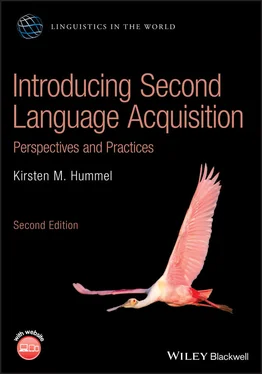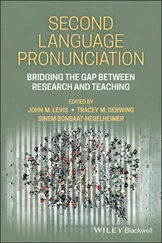1 Cover
2 Title Page Introducing Second Language Acquisition Perspectives and Practices Second Edition Kirsten M. Hummel
3 Copyright Page
4 Dedication Page
5 Preface
6 Acknowledgments
7 About the Companion Website
8 1 Introduction reference
9 2 First Language Acquisition 2.1 chapter overview 2.2 from sound to word 2.3 from word to sentence 2.4 theoretical views 2.5 first language vs second language acquisition 2.6 summing up key concepts self‐assessment questions discussion questions exercises / project ideas references further reading and viewing
10 3 Language Learning Contexts 3.1 chapter overview 3.2 naturalistic contexts 3.3 instructed learning / instructed second language acquisition 3.4 summing up key concepts self‐assessment questions discussion questions exercises / project ideas references further reading and viewing
11 4 Theoretical Perspectives 4.1 chapter overview 4.2 contrastive analysis 4.3 error analysis 4.4 universal grammar 4.5 the monitor model / input hypothesis 4.6 the sociocultural approach 4.7 summing up key concepts self‐assessment questions discussion questions exercises / project ideas references further reading and viewing
12 5 Theoretical Perspectives: Cognitive Approaches 5.1 chapter overview 5.2 information processing / cognitive approach 5.3 skill acquisition theory 5.4 the interaction approach 5.5 input processing 5.6 emergentism and usage‐based approaches 5.7 summing up key concepts self‐assessment questions discussion questions exercises / project ideas references further reading and viewing
13 6 Teaching Approaches and Instructional Issues 6.1 chapter overview 6.2 historical and current perspectives on language teaching 6.3 classroom instructional issues 6.4 summing up key concepts self‐assessment questions discussion questions exercises / project ideas references further reading and viewing
14 7 Second Language Development 7.1 chapter overview 7.2 common processes and influences 7.3 L2 development across linguistic subfields 7.4 investigating learner language: language corpora 7.5 summing up key concepts self‐assessment questions discussion questions exercises / project ideas references further reading and viewing
15 8 The Age Factor 8.1 chapter overview 8.2 the critical period hypothesis 8.3 abnormal instances: children raised in isolation 8.4 empirical studies 8.5 exceptional cases 8.6 summing up key concepts self‐assessment questions discussion questions exercises / project ideas references further reading and viewing
16 9 Individual Differences 9.1 chapter overview 9.2 intelligence 9.3 language learning aptitude 9.4 attitudes and motivation 9.5 personality 9.6 learning style and cognitive style 9.7 learning strategies 9.8 summing up key concepts self‐assessment questions discussion questions exercises / project ideas references further reading and viewing
17 10 Bilingualism and Multilingualism 10.1 chapter overview 10.2 bilingual development 10.3 bilingual lexical representation and lexical access 10.4 bilingual cognition 10.5 multilingualism 10.6 summing up key concepts self‐assessment questions discussion questions exercises / project ideas references further reading and viewing
18 11 Concluding Words 11.1 conclusion 11.2 epilogue
19 Glossary
20 Index
21 End User License Agreement
1 Chapter 2 Table 2.1 Development of babbling. Table 2.2 Order of acquisition of English morphemes.
2 Chapter 3 Table 3.1 Descriptions of predominant language teaching/learning contexts.
3 Chapter 4Table 4.1 Error analysis procedures.
4 Chapter 7Table 7.1 Unmarked‐marked examples.Table 7.2 Order of English L2 morpheme acquisition.Table 7.3 German L2 word‐order emergence stages.Table 7.4 Adverb placement in French and English.Table 7.5 ESL question development.Table 7.6 Five stages in buying stamps.
5 Chapter 8Table 8.1 Summary of some key critical/sensitive period studies.
6 Chapter 9Table 9.1 Distinctions among types of motivation.Table 9.2 Learning strategies classification.
7 Chapter 10Table 10.1 Types of bilingual.
1 Chapter 1 Cartoon 1.1 2/15/2000, http://www.reverendfun.com/needyreverendfun.com.
2 Chapter 2 Cartoon 2.1 Mike Baldwin/CartoonStock.com. Figure 2.1 English L1 and Hindi L1 infant perception of Hindi consonant cont... Figure 2.2 Development of MLU in three children (Brown, 1973) and children i... Figure 2.3 Berko's (1958) Wug test. Figure 2.4 U‐shaped curve representing the learning of irregular grammatical... Cartoon 2.2 Mike Williams/CartoonStock.com. Cartoon 2.3 Marty Bucella/CartoonStock.com.
3 Chapter 3 Cartoon 3.1 Clive Goddard/CartoonStock.com. Cartoon 3.2 John Hills/CartoonStock.com. Cartoon 3.3 Rex May Baloo/CartoonStock.com. Cartoon 3.4 Just Kidding by Rod Maclean.
4 Chapter 4Figure 4.1 Three hypotheses for the role of UG in SLA: direct access; indire...Figure 4.2 Krashen's Monitor Model.
5 Chapter 5Figure 5.1 Atkinson and Shiffren's information processing model.Figure 5.2 Influences upon noticing.Figure 5.3 Where input processing (IP) fits into an acquisition scheme.Figure 5.4 Illustration of network of neuron‐like units and links in connect...
6 Chapter 6Figure 6.1 Figure from THE BERLITZ SELF‐TEACHER: SPANISH,Cartoon 6.1 Audiolingual Method. Mishon Joel/CartoonStock.com.Cartoon 6.2 Cartoon illustrating English speaker's incomprehension of dialec...Cartoon 6.3 www.funnytimes.com.Figure 6.2 Drawing A / Drawing B. Illustration for Processing Instruction ap...
7 Chapter 7Cartoon 7.1 Sidney Harris/CartoonStock.com.Cartoon 7.2 funnytimes.com.Figure 7.1 Principal differences between L1 and L2 student writing: implicat...
8 Chapter 8Figure 8.1 Critical period for parental imprinting in ducklings.Cartoon 8.1 Naf/CartoonStock.com.Figure 8.2 Average foreign accent ratings for 240 native speakers of Italian...Figure 8.3 Patkowski (1980) study. Bar charts showing population frequencies...Figure 8.4 Results from Johnson and Newport (1989). The relationship between...
9 Chapter 9Figure 9.1 Examples of MLAT items.Figure 9.2 Working memory model.Cartoon 9.1 Atlantic Feature Syndicate/dba Mark Parisi. Mark Parisi/Off The ...Figure 9.3 Relationship of variables in Gardner's motivation construct.Figure 9.4 The components of motivational teaching practice in the L2 classr...Figure 9.5 GEFT (Group Embedded Figures Test).
10 Chapter 10Cartoon 10.1 “Delusion Springs Maternal,” 5/3/2011, by John Crowther.Figure 10.1 Languages in contact: Findings and Problems.Figure 10.2 Revised hierarchical model.Figure 10.3 Three‐store view of bilingual lexical organization: a single non...Figure 10.4 The modified hierarchical model.
1 Cover
2 Table of Contents
3 Begin Reading
1 ii
2 iii
3 iv
4 v
5 xiii
6 xv
7 xvi
8 xv
9 1
10 2
11 3
12 4
13 5
14 6
15 7
16 8
17 9
18 10
19 11
20 12
21 13
22 14
23 15
24 16
25 17
26 18
27 19
28 20
29 21
30 22
31 23
32 24
33 25
34 26
35 27
36 28
37 29
38 30
39 31
40 32
41 33
42 35
43 36
44 37
45 38
46 39
47 40
48 41
49 42
50 43
51 44
52 45
53 46
54 47
55 48
56 49
57 50
58 51
59 52
60 53
61 54
62 55
63 56
64 57
65 58
66 59
67 60
68 61
69 63
70 64
71 65
72 66
73 67
Читать дальше












